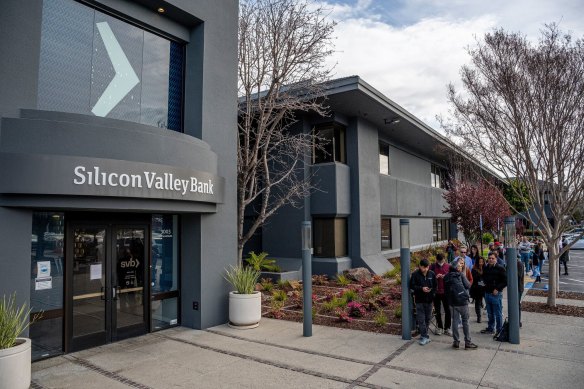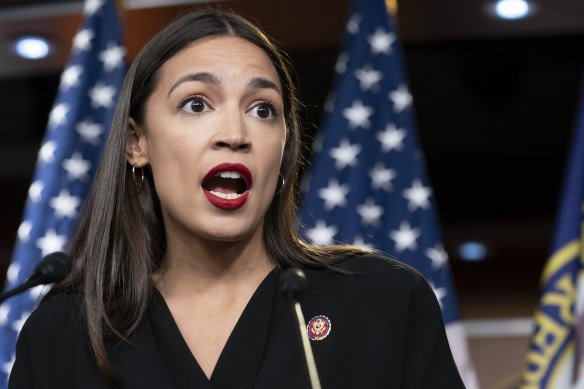An extremely online crisis: How Silicon Valley Bank unravelled
Democratic congressman Jeff Jackson was standing at his North Carolina home at about 2am Monday, local time, dressed in a hooded jumper and a cloak of earnestness. He was explaining why Silicon Valley Bank had collapsed and imploring what eventually totalled more than 23 million viewers on TikTok not to panic about the financial system.
“You are undoubtedly the most transparent representative I’ve seen in my lifetime,” wrote one commenter. “Thank you, sir.”
From the early seeds of the crisis sown years before, to the way the crisis spread and was managed online by people such as Jackson, to the blame game over the fallout from the failure of Silicon Valley Bank and another in New York called Signature Bank, the whole saga has been intertwined with technology.
Silicon Valley Bank was founded in 1983. It prospered along with America’s burgeoning start-up industry, riding the wave of the dotcom boom and bust and then enjoying another period of rapid growth as the sector boomed during the pandemic.
The amount of money deposited with the bank went from about $US50 billion ($75 billion) in 2018 to about $US210 billion just before it failed, as investors tried to avoid low interest rate returns by betting on nascent technology companies with claims of world-changing potential.
SVB liked that image and fostered it with easy banking and loan services, including to Australian start-ups that sometimes had a hard time being taken seriously elsewhere in the US financial system.
“It all looked very nice,” says one entrepreneur, Ben Sand, whose company Strong Compute had money with SVB. “There were a couple of receptionists there and a wine collection [from the bank’s side bet on local vineyards] and it’s like going into a venture firm office or something.”
Customers in line outside Silicon Valley Bank headquarters in Santa Clara, California, US, on March 13.Credit:Bloomberg
The problem with having such a large base of start-up customers is that they tend not to need as many loans as regular bank customers, whether individuals or companies, because during the boom years they could rely on their investors putting more money in to fuel their expansion plans. To make money, SVB invested more than $US20 billion in long-term bonds that were paying what looked to be attractive interest rates of about 1.75 per cent during the pandemic. But when inflation came roaring back and interest rates jumped to 4.5 per cent in the US, those bonds looked like a terrible investment.
Inflation undermined the start-up sector too, as investors grew leery of loss-making firms. The amount of venture capital flowing into start-ups in the Americas fell by 36 per cent from record highs in 2021 to 2022, according to data firm Dealroom. The fall was 40 per cent in Asia and Oceania. That forced more start-ups to withdraw their savings from SVB. To cover withdrawals, SVB had to sell its bonds, recording a $US1.8 billion loss that would require fresh capital to make up for.
That disclosure started a contagious fear. All industries talk, but few do it like start-ups where industry figures are constantly on the social media network Twitter along with discussion platforms Slack and Discord.
When high-profile venture capitalists began telling the companies they had invested in to get their cash out of SVB, it started a bank run that spread instantly throughout these hyper-connected circles.
“Panic,” observed Australian start-up investor Niki Scevak, a partner at Blackbird Ventures, “has strong network effects.”
Over the last weekend, the crisis moved from the technology world to the real world. Other regional banks started looking shaky. A sector that sees itself as the smartest and most innovative part of the economy risked being blamed for spreading financial contagion.
All industries talk, but few do it like start-ups where industry figures are constantly on the social media network Twitter along with discussion platforms Slack and Discord.
James Alexander, a co-founder of the smaller Australian venture capital fund Galileo Ventures, was socialising after work in Boston. “You know it starts hitting the zeitgeist when you’re… in a Boston sports bar and having it come on TV between games in the news break and people starting to pay attention,” Alexander said. “People in the bar wanted to hear it.”
Ultimately regulators stepped in to shut the bank and guarantee deposits at SVB, along with another firm called Signature Bank of New York that had branched out from its real estate and legal clients to do business in the controversial cryptocurrency sector. The fact that both banks’ shareholders will be wiped out and depositors will be repaid from a levy on other banks has not stopped a wave of recriminations.
Democratic congresswoman and left-wing standard-bearer Alexandria Ocasio-Cortez argued that Silicon Valley figures who lobbied for weaker banking regulations granted by former president Donald Trump were at fault. “I haven’t seen a single one of these guys crying for a bailout take a single ounce of accountability for their actions,” she said. “It’s honestly shameless.”
Fox News commentators blamed “woke” practices at Silicon Valley Bank, suggesting without evidence that diversity had been a distraction from proper management. Cryptocurrency boosters claimed the crisis showed why the world needed alternative financial systems, notwithstanding the wave of failures in that sector last year.
Democrat progressive Alexandria Ocasio-Cortez blamed Silicon Valley figures who lobbied for weaker banking regulations for the collapse.Credit:AP
Finance author Nicholas Nassim Taleb pointed the finger at venture capitalists, blaming them for stuffing SVB full of cheap money, causing a run and then begging for a bailout of deposits. “They are all libertarians until they are hit by higher interest rates,” Taleb said.
And libertarian-minded venture capitalist David Sacks hit back, rejecting that “tech bros” were to blame and saying spending by the US federal government had exacerbated inflation and ultimately brought down SVB.
Behind this debate, which will be hashed out in the US Congress and the courts as claimants pursue SVB, a more tangible question looms for the technology sector: who to bank with?
Bailador Technology Investments managing partner David Kirk said SVB had helped start-ups for almost 40 years. “It’s actually quite a tragedy … to see it disappear,” said Kirk, whose fund has a stake in one firm that banked with SVB.
Cliff Obrecht, the chief operating officer and co-founder of Australia’s largest privately held technology company, Canva, said that his company would back SVB if it is sold and keeps operating. “They have supported Canva from day one when we had nothing and are an incredible team of humans who offer great services and products,” Obrecht said. “To not have SVB in the start-up and growth company ecosystem would be a huge loss.”
The Business Briefing newsletter delivers major stories, exclusive coverage and expert opinion. Sign up to get it every weekday morning.
Most Viewed in Business
From our partners
Source: Read Full Article


